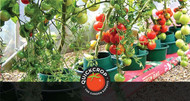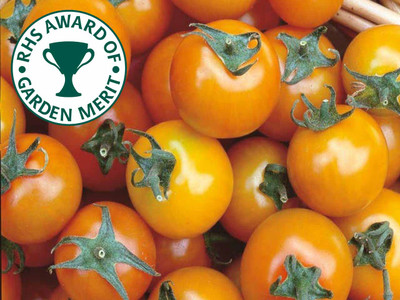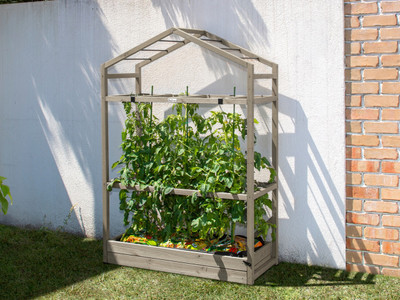How To Grow Tomatoes In Containers

Tomatoes can be grown in containers like pots, planters, growbags, and hanging baskets, they may not be the easiest plant to grow at home but they are definitely one of the favourites. There are many factors that can contribute to the failure of your tomato plants like bad weather, lack of nutrients, poor plant protection or pest control, and inadequate space for the growing plants.
While changeable weather is just something we have to deal with as a matter of course, everything else can be managed. Growing in containers minimises damage from wildlife, and because it is always better to use new potting soil in pots, resistance to pests and diseases common to the garden is increased. If you follow these steps when growing tomatoes in containers you can maximise the chances of a healthy and delicious tomato crop.

What Size Do Containers Need To Be For Tomatoes?
The most important thing to get right when growing tomatoes in containers is the size of the pot or planter. The golden rule here is the bigger the better. Larger containers hold more soil, which means it will hold more water and will be able to feed more nutrients to the growing tomatoes. Young tomato plants are very hungry and thirsty and require a consistent and reliable food and water source.
Tomato containers need to be a minimum of 40 litres (about 60 litres is ideal to give the roots adequate room to develop), with only one to two tomato plants per container. For pots, a minimum size of 18in diameter for determinate tomato varieties and 24in diameter for indeterminate is needed. Smaller varieties of tomato can be grown in smaller containers but they will require extra feeding and watering. Make sure each container has drainage holes unless they are of the fabric variety.

Positioning Tomato Plants
Tomatoes thrive in hotter climates, so in our gardens they need to be placed somewhere that gets as much sun as possible and against a wall or a fence. An area that gets about 6 to 8 hours a day of direct sunlight is ideal, and the great thing about growing in containers is that they can be moved throughout the season or even day to avail of brighter spots.
In most parts of the UK and Ireland, tomatoes will be much better grown under a cover, as even in our best summers our weather is inconsistent. The good news is you don't need a greenhouse or polytunnel to provide cover as a huge range of tomato cloches, frames, and other structures are readily available. I favour the pop-up tomato cloche when growing in pots because it's light and has in-built air vents for circulation.

Starting Tomatoes In Pots
Firstly, add a layer of small stones or pebbles to the bottom of the plant pot to increase drainage, this is not strictly necessary but definitely helps. Next, add a nice mix of potting soil and vegetable fertiliser until the container is about a third full. Most potting soils do not have enough nutrients for tomato plants so some fertilizer must be added. After that place the tomato plant in the centre and fill with your potting mix until it is even with the soil line of the plant.
Water thoroughly and the re-water about ten or fifteen minutes later until the soil is soaking. After this step the plant will probably not need to be watered for a few days or a week. If you are growing from seed, add the layer of pebbles or stones and then fill the container up to about an inch from the top. Make a small hole in the middle of the pot and place two tomato seeds in (to increase chances), and then cover over with soil. When watering, do it gently so as not to disturb the seeds too much.

How Often Should I Water My Tomato Plants In Pots?
This is the most important thing to get right with container growing, the soil in containers heats up faster than the ground and this leads to more water evaporation, so tomatoes in pots need more water than growing them in the ground. The soil needs to be kept moist at all times but not saturated. Depending on the weather, a tomato plant might need to be watered more than once every day. A simple trick is to check the top two inches of soil in the pot by sticking your finger down, if your fingertip comes out dry then it is time for a watering. Irrigation systems will really pay for themselves here if you are growing multiple tomato plants, a good drip irrigation system can deliver a consistent supply of water as needed. If watering by hand, make sure to really soak the plants, watering the soil rather than the foliage.
Just like under watering will harm the plants; over watering will also kill them. This is why drainage holes are extremely important in containers growing tomatoes; so any excess water can drain out. Water your plants until you can see water coming out the bottom as this will show you that you have watered the entire plant and all the roots. If you can't see any water run out the bottom then the pot might be too tight to the surface causing excess liquid to remain within the container. In this case the planter can be placed on a layer of stones or pebbles to create air pockets that aid drainage.

What kind of tomatoes grow best in containers?
Determinate varieties are the best variety of tomato to grow in containers, these are also known as bush or compact varieties. Determinate tomatoes require less space to grow in, making them ideally suited to pots, containers, or hanging baskets and quite reliable anywhere that space is at a premium. These varieties also do not grow with a central stem and have a low growing, sprawling habit that makes them great for growing under cloches or other tomato plant protection. Dwarf varieties can also be grown with great success in pots and containers, these are very small and compact tomato plants that grow no more than eight inches high and won't outgrow the cloche or cover. All of this is not to say that Indeterminate varieties can not be grown as well, they just need larger containers and adequate vine support.
Click for a comprehensive article on . This article is a part of our Learning centre and contains all you need to know from troubleshooting issues and how to combat pests and diseases to harvesting and storing tomatoes.




